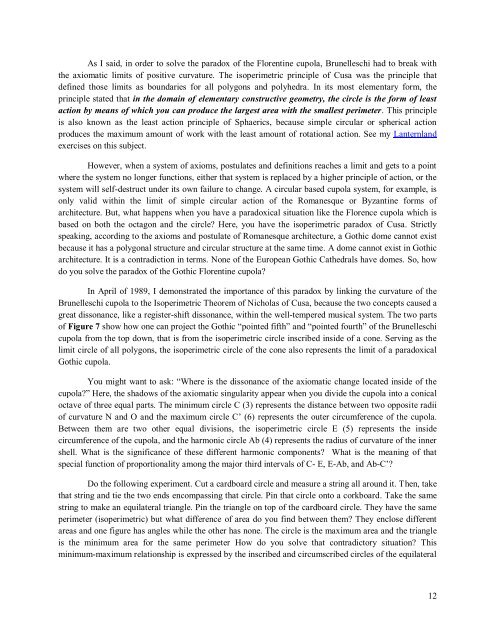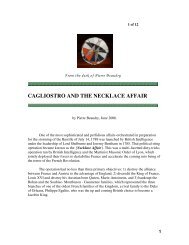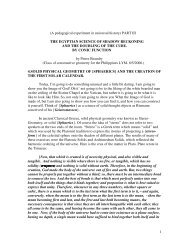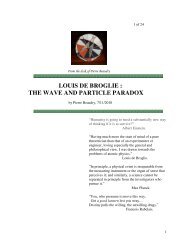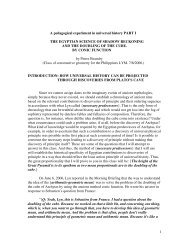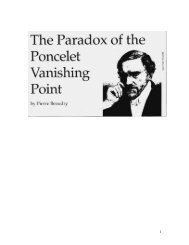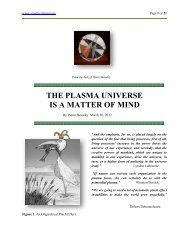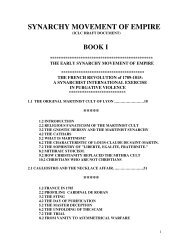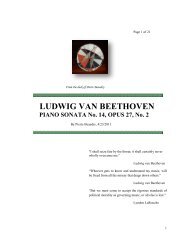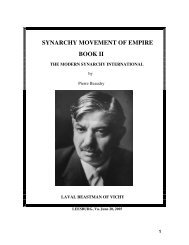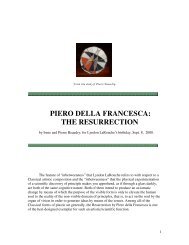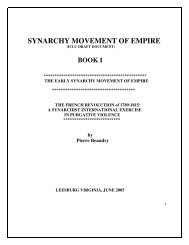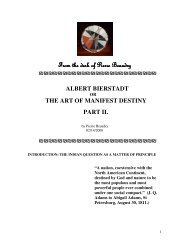filippo brunelleschi's mind and the catenary principle - Pierre ...
filippo brunelleschi's mind and the catenary principle - Pierre ...
filippo brunelleschi's mind and the catenary principle - Pierre ...
Create successful ePaper yourself
Turn your PDF publications into a flip-book with our unique Google optimized e-Paper software.
As I said, in order to solve <strong>the</strong> paradox of <strong>the</strong> Florentine cupola, Brunelleschi had to break with<strong>the</strong> axiomatic limits of positive curvature. The isoperimetric <strong>principle</strong> of Cusa was <strong>the</strong> <strong>principle</strong> thatdefined those limits as boundaries for all polygons <strong>and</strong> polyhedra. In its most elementary form, <strong>the</strong><strong>principle</strong> stated that in <strong>the</strong> domain of elementary constructive geometry, <strong>the</strong> circle is <strong>the</strong> form of leastaction by means of which you can produce <strong>the</strong> largest area with <strong>the</strong> smallest perimeter. This <strong>principle</strong>is also known as <strong>the</strong> least action <strong>principle</strong> of Sphaerics, because simple circular or spherical actionproduces <strong>the</strong> maximum amount of work with <strong>the</strong> least amount of rotational action. See my Lanternl<strong>and</strong>exercises on this subject.However, when a system of axioms, postulates <strong>and</strong> definitions reaches a limit <strong>and</strong> gets to a pointwhere <strong>the</strong> system no longer functions, ei<strong>the</strong>r that system is replaced by a higher <strong>principle</strong> of action, or <strong>the</strong>system will self-destruct under its own failure to change. A circular based cupola system, for example, isonly valid within <strong>the</strong> limit of simple circular action of <strong>the</strong> Romanesque or Byzantine forms ofarchitecture. But, what happens when you have a paradoxical situation like <strong>the</strong> Florence cupola which isbased on both <strong>the</strong> octagon <strong>and</strong> <strong>the</strong> circle? Here, you have <strong>the</strong> isoperimetric paradox of Cusa. Strictlyspeaking, according to <strong>the</strong> axioms <strong>and</strong> postulate of Romanesque architecture, a Gothic dome cannot existbecause it has a polygonal structure <strong>and</strong> circular structure at <strong>the</strong> same time. A dome cannot exist in Gothicarchitecture. It is a contradiction in terms. None of <strong>the</strong> European Gothic Ca<strong>the</strong>drals have domes. So, howdo you solve <strong>the</strong> paradox of <strong>the</strong> Gothic Florentine cupola?In April of 1989, I demonstrated <strong>the</strong> importance of this paradox by linking <strong>the</strong> curvature of <strong>the</strong>Brunelleschi cupola to <strong>the</strong> Isoperimetric Theorem of Nicholas of Cusa, because <strong>the</strong> two concepts caused agreat dissonance, like a register-shift dissonance, within <strong>the</strong> well-tempered musical system. The two partsof Figure 7 show how one can project <strong>the</strong> Gothic “pointed fifth” <strong>and</strong> “pointed fourth” of <strong>the</strong> Brunelleschicupola from <strong>the</strong> top down, that is from <strong>the</strong> isoperimetric circle inscribed inside of a cone. Serving as <strong>the</strong>limit circle of all polygons, <strong>the</strong> isoperimetric circle of <strong>the</strong> cone also represents <strong>the</strong> limit of a paradoxicalGothic cupola.You might want to ask: “Where is <strong>the</strong> dissonance of <strong>the</strong> axiomatic change located inside of <strong>the</strong>cupola?” Here, <strong>the</strong> shadows of <strong>the</strong> axiomatic singularity appear when you divide <strong>the</strong> cupola into a conicaloctave of three equal parts. The minimum circle C (3) represents <strong>the</strong> distance between two opposite radiiof curvature N <strong>and</strong> O <strong>and</strong> <strong>the</strong> maximum circle C’ (6) represents <strong>the</strong> outer circumference of <strong>the</strong> cupola.Between <strong>the</strong>m are two o<strong>the</strong>r equal divisions, <strong>the</strong> isoperimetric circle E (5) represents <strong>the</strong> insidecircumference of <strong>the</strong> cupola, <strong>and</strong> <strong>the</strong> harmonic circle Ab (4) represents <strong>the</strong> radius of curvature of <strong>the</strong> innershell. What is <strong>the</strong> significance of <strong>the</strong>se different harmonic components? What is <strong>the</strong> meaning of thatspecial function of proportionality among <strong>the</strong> major third intervals of C- E, E-Ab, <strong>and</strong> Ab-C’?Do <strong>the</strong> following experiment. Cut a cardboard circle <strong>and</strong> measure a string all around it. Then, takethat string <strong>and</strong> tie <strong>the</strong> two ends encompassing that circle. Pin that circle onto a corkboard. Take <strong>the</strong> samestring to make an equilateral triangle. Pin <strong>the</strong> triangle on top of <strong>the</strong> cardboard circle. They have <strong>the</strong> sameperimeter (isoperimetric) but what difference of area do you find between <strong>the</strong>m? They enclose differentareas <strong>and</strong> one figure has angles while <strong>the</strong> o<strong>the</strong>r has none. The circle is <strong>the</strong> maximum area <strong>and</strong> <strong>the</strong> triangleis <strong>the</strong> minimum area for <strong>the</strong> same perimeter How do you solve that contradictory situation? Thisminimum-maximum relationship is expressed by <strong>the</strong> inscribed <strong>and</strong> circumscribed circles of <strong>the</strong> equilateral12


